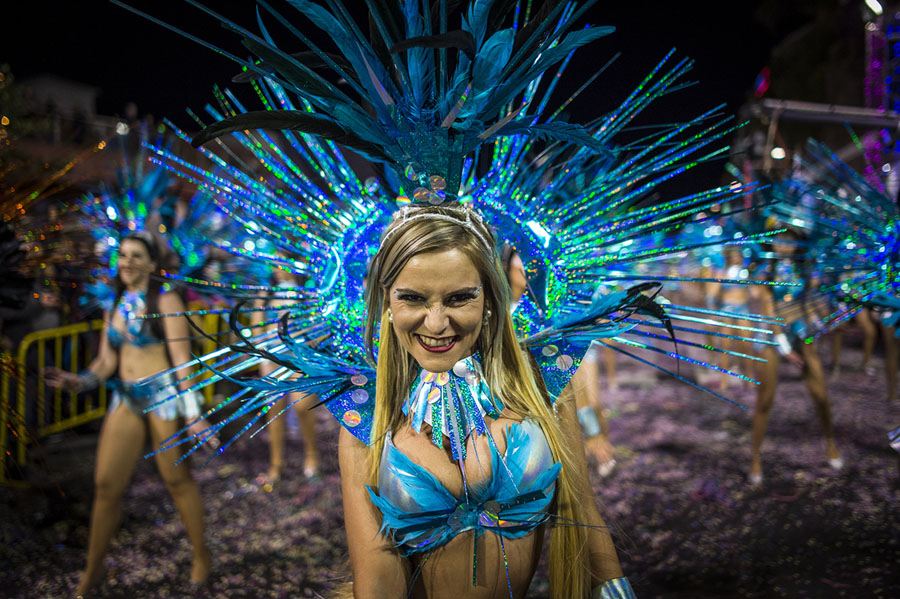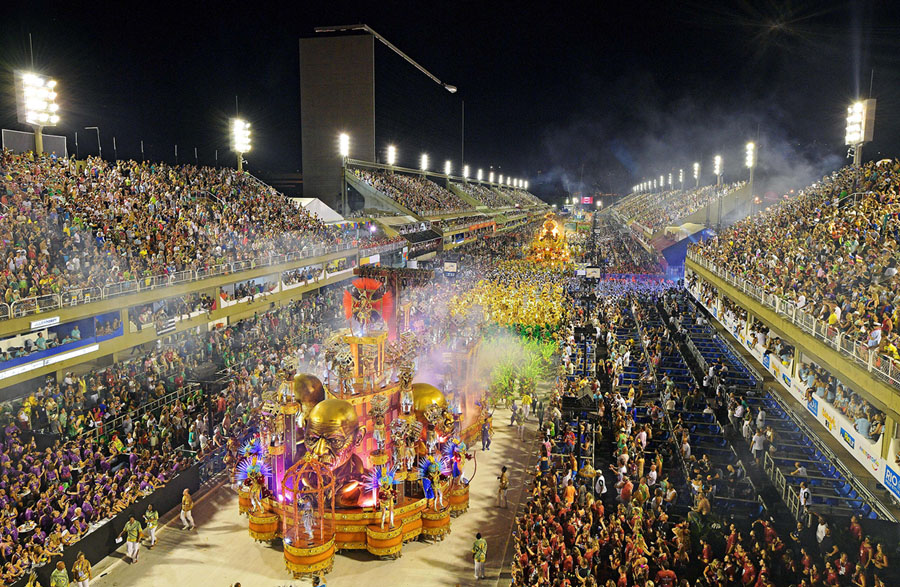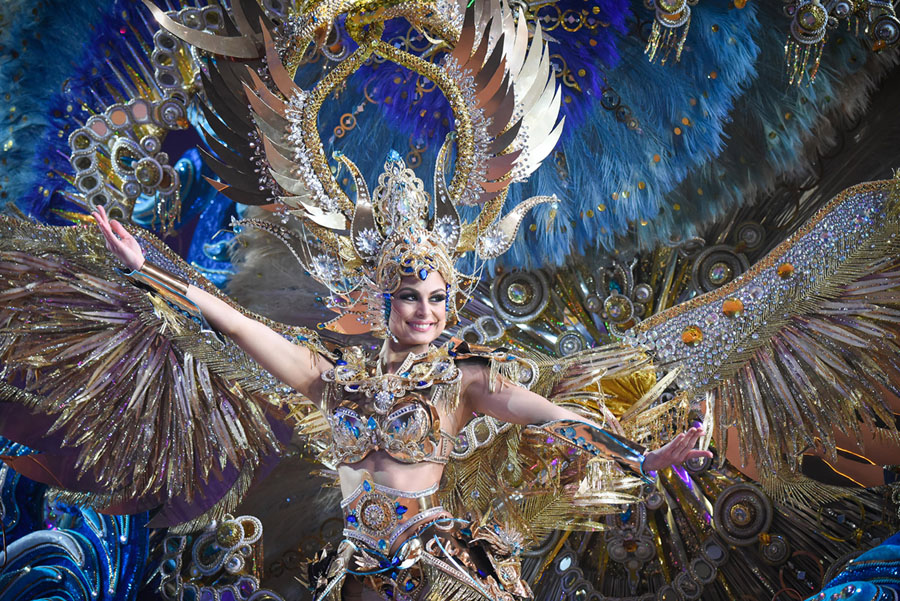Carnival season 2018 is underway across Europe and the Americas. These pre-Lent festivals, often a blend of local pagan and Catholic traditions, usher out winter and welcome in spring. The largest and most famous—the Carnival in Rio de Janeiro, Brazil—took place over the past few days. Gathered here are images of Carnivals around the world, including images from Brazil, Portugal, Hungary, Bolivia, Haiti, Spain, Italy, and more. Depending on available photos, there may be a follow-up post later this week with more from Mardi Gras and other celebrations.
Photos of Carnival 2018 Around the World
-
![]() Read more
Read moreDancers from the Caneca Furada troupe perform in the Carnival Parade in Funchal with the theme "Madeira: six centuries of joy" on February 10, 2018, in Funchal, Madeira, Portugal. #
Octavio Passos / Getty -
-
![]() Read more
Read moreCarnival revelers ride down the Schiltach stream atop their float during the "bach na fahre" (race down the stream) raft contest on Rose Monday in the southwestern Black Forest town of Schramberg, Germany, on February 12, 2018. #
Steffen Schmidt / Reuters -
-
![]() Read more
Read moreA mud-covered reveler poses during the traditional "Bloco da Lama" or "Mud Block" carnival party in Paraty, Brazil, on February 10, 2018. Hundreds of revelers wrestled, tackled each other, and threw chunks of gunk Saturday while shaking it to samba and reggaeton at a Carnival beach party where clothes were optional but the mud was not. #
Leo Correa / AP -
![]() Read more
Read moreIn Ivrea, Italy, people throw oranges at each other during the traditional "Oranges Battle" of Ivrea Carnival, near Turin, on February 11, 2018. Established in 1808, the Carnival of Ivrea is one of the oldest and most particular festivals in the world. It is the Battle of the Oranges that evokes the civil war that broke out between the people of Ivrea and the Royal Napoleonic Troops. The battle is made up of squads of aranceri (or orange throwers on foot, representing the people) and those defending their piazzas from the oranges (which represent arrows) on carts (representing the Napoleonic troops). #
Miguel Medina / AFP / Getty -
-
![]() Read more
Read moreA "Federhannes" Carnival character jumps in the streets of Rottweil, southern Germany, during the "Narrensprung" (Jump of the Fools) Carnival parade on Rose Monday on February 12, 2018. #
Thomas Kienzle / AFP / Getty -
![]() Read more
Read moreA reveler dressed as an infant with a white dress stands in a street during "El Gallo de Carnaval" (The Carnival Rooster) of Mecerreyes on February 11, 2018, in Mecerreyes, Burgos province, Spain. The Gallo de Carnaval of Mecerreyes is an ancient pagan festival. During the "Carnavaladas y Zarramacadas," characters take the streets with dressed with ropes, bones, skins, scraps of cloth, oak leaves, and other rural items. At the end of the festival the Zarramacos chase young revelers who try to steal a rag rooster from "El Rey" (The King). #
Pablo Blazquez Dominguez / Getty -
![]() Read more
Read moreA group of participants called ''Txatxus'' take part in an ancient rural Carnival in the small Pyrenees village of Lantz, northern Spain, on February 11, 2018. The Carnival is a long-standing rural tradition in which the forces of good and evil confront each other in a symbolic battle. From Sunday to Tuesday, during Carnival week, in the little village of Lantz the legendarily evil bandit Miel Otxin, represented by a doll filled with straw, is imprisoned and sentenced to death by fire. #
Alvaro Barrientos / AP -
-
![]() Read more
Read moreA reveler performs on the first day of the 2018 National Carnival Parade on February 11, 2018, in Port-au-Prince, Haiti. The name of the Carnival for this year in Haitian creole is "Ayiti sou wout chanjman" (Haiti on the road to change). #
Hector Retamal / AFP / Getty -
-
![]() Read more
Read moreDancers perform the traditional Diablada in Oruro, Bolivia, on February 10, 2018. Thousands of colorfully dressed dancers and musicians kick off Carnival celebrations in the Bolivian city of Oruro. #
Juan Karita / AP -
![]() Read more
Read moreDancers perform during the second day of the Bissau Carnival on February 11, 2018 in Bissau, Guinea-Bissau. The 2018 edition of the Bissau Carnival, celebrating diversity and nature, is held from February 10 to 13. #
Xaume Olleros / AFP / Getty -
![]() Read more
Read moreA nominee for queen performs during the main stage of the Carnival of Santa Cruz in Santa Cruz de Tenerife on the Spanish Canary island of Tenerife, on February 7, 2018. #
Desiree Martin / AFP / Getty -
-
![]() Read more
Read moreA child wearing a carnival costume looks up at a man wearing a costume in St. Mark's Square on February 10, 2018, in Venice, Italy. The theme for the 2018 edition of Venice Carnival is 'Playing,' and it runs from January 27 to February 13. #
Awakening / Getty -
![]() Read more
Read moreMusicians and children perform at Palazzo Pisani Moretta during the annual Ballo del Doge in Venice, Italy, on February 10, 2018. The Ballo del Doge, created by fashion and costume designer Antonia Sautter, is considered the most elegant and exclusive masquerade ball during the Venice Carnival. #
Awakening / Getty -
![]() Read more
Read moreMembers of the "Bloco Ultima Hora" group ride atop boats during the Carnival of the Waters, where costumed and colorful boats navigate the river Tentem around the islands near the city of Cameta, Brazil, on February 10, 2018. #
Ueslei Marcelino / Reuters -
-
![]() Read more
Read moreA dancer from Mocidade Samba School performs with electricity during the first night of the Carnival parade at the Sambadrome in Rio de Janeiro on February 12, 2018. #
Pilar Olivares / Reuters -
-
![]() Read more
Read moreA photograph taken during the parade of the Mangueira Samba School during the first night of Rio's Carnival at the Sambadrome in Rio de Janeiro, on February 12, 2018. #
Mauro Pimentel / AFP / Getty -
![]() Read more
Read moreA reveler wearing a sheep's wool costume with horns and a mask stands in front of a bonfire in Mohacs, Hungary, during the traditional Carnival parade of the town on February 11, 2018. The Carnival parade of people dressed in similar costumes and frightening wooden masks, using various noisy wooden rattlers is traditionally held on the seventh weekend before Easter to drive away winter, and is a revival of a legend, which says the ethnic Croats crossed the river to ambush the Osmanli Turkish troops, who escaped in panic seeing the terrifying figures during the Turkish occupation of Hungary. #
Zsolt Szigetvary / MTI via AP







































